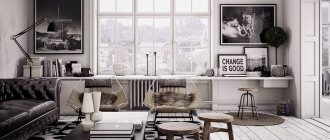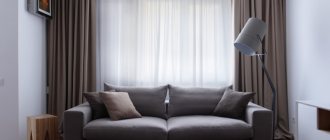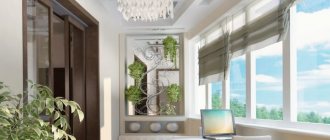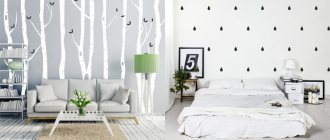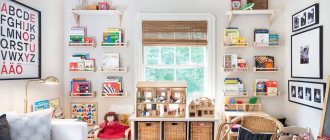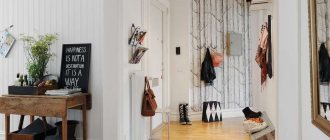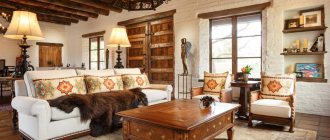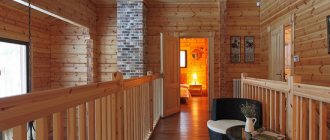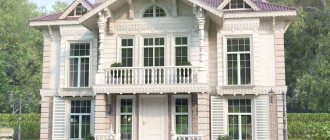Features of the Scandinavian style
The Scandinavian style in architecture originated in the Nordic countries; it is very diverse and interesting. His geographical homeland is Finland and Norway, but most of all he has absorbed Swedish traditions. Although this trend originated in the early Middle Ages, it appeared as an independent phenomenon only during the reign of the Swedish king Gustav III, and became widespread in the mid-20th century.
The principles of construction, interior design, and architectural appearance were formed under the influence of the harsh climate and practicality of the northern peoples living on the territory of the largest peninsula in Europe. The houses are devoid of pretentiousness, they are characterized by simple office design, durability, and retain heat well. The main distinctive features of this direction include:
- simple design;
- low-rise, Scandinavians do not build tall structures, mostly there are projects of one-story structures, less often two floors;
- strict geometric shapes, straight lines;
- a characteristic gable roof with a steep slope, but there are projects with a pitched, sloping roof;
- the presence of large windows, panoramic glazing is allowed;
- an impressive porch or terrace;
- use of natural, environmentally friendly materials in construction;
- minimal use of decorative elements;
- simplicity and conciseness of interior decoration;
- rational use of internal space;
- application of energy-saving technologies.
A Scandinavian house is a modern structure that will not lose its relevance for many years. This is an environmentally friendly home with spacious and bright rooms, very comfortable and cozy, filled with natural light as much as possible.
Roof
Considering that in the Scandinavian countries a lot of snow falls in winter, the roofs of houses are often made gable, with a steep slope. This way the snow melts away faster without creating unnecessary stress on the roof.
Their shape can be either classic or asymmetrical. Mansard roofs with windows are common, making it possible to effectively use the attic space.
The roofing material is metal tiles or modern polymer materials. Different colors are allowed, depending on the design of the house. In Norway, there is another original way of decorating roofs - grass is planted on them.
Types of frame house kits
Frame house construction is typical for many northern countries. Low-rise prefabricated structures are popular not only in Scandinavia or Finland, but are also in great demand in the USA, Germany, and Japan. The technology for constructing a residential structure consists of assembling it from ready-made elements. The components used for work differ only in the degree of readiness. Based on the type of house kits, 4 main groups can be distinguished:
- Ready blocks. Entire modules are assembled at the manufacturer's factory. At the construction site, the structure is erected from prepared components. However, this type of construction is quite rare, as problems arise with transportation and installation of large components.
- House kit of a high degree of readiness. Kits are brought to the construction site, which are parts of walls that have external finishing, rough internal cladding, doors, thermal insulation, and vapor barrier materials are inserted into them.
- Designs with base panels. The blocks are less prepared. Facade finishing, insulation, installation of windows and doors is carried out on site.
- Pre-cut ingredients. All frame components are pre-fabricated at the enterprise, numbered, and their connection is carried out on the construction site according to the instructions. Finishing materials are supplied uncut.
Modern Scandinavian house
Mirror lakes, majestic evergreen forests and high snow-capped mountains have determined the appearance of a modern Scandinavian home since ancient times. Practical and discreet, but at the same time amazingly beautiful due to its naturalness and proximity to natural forms and shades, a Scandinavian house is the embodiment of a cozy and comfortable life in the harsh climatic conditions of the northern latitudes of the planet.
Today, Scandinavian houses are usually divided into classic and modern. Classic Scandinavian buildings can be found in almost every locality in Karelia. This is due to its territorial proximity to Finland. At the same time, modern, beautiful and functional architectural solutions are very rare in our country. And therefore, it is on the modern architecture of a Scandinavian house that we will focus our main attention.
Practical architecture
Despite the absence of convex and catchy decorative elements on the facade, modern Scandinavian houses are not at all alien to non-standard forms and constructivism. But even if such a house looks unusual visually, it still retains its main features: four walls, a pitched or gable roof, high panoramic windows and a high porch.
Aggressive architectural solution for a Scandinavian home with an emphasis on constructiveness
The walls are most often made of natural wood. Moreover, the natural beige color of the wood is always preserved - it is covered with a protective transparent or tinted coating. Classic houses were painted: in Sweden and Finland bright red, in Norway and Iceland blue. In modern houses you can increasingly find brick and concrete structures, but they are also often covered on the outside with lining, wooden panels and facade boards.
The roof of the house is tiled or polymer, but always dark gray, dark brown or black. The dark color was not chosen by chance - it absorbs solar heat more than all others, and a large layer of snow thaws faster, sliding off the roof slopes and relieving it of the load. In Iceland and Norway you can often find so-called extensive roof landscaping - the entire surface of the roof is filled with lawn grass.
The windows in a Scandinavian house are always large. Living in eternal darkness and without the sun for three seasons, the northern resident looked for light everywhere. Large panoramic windows that span the entire wall are the most practical solution for accumulating light in a room. The reader should not be confused by the issue of thermal insulation - modern double-glazed windows have a number of effective solutions for preserving heat in the room. Window frames are always made of natural wood. And the color solutions are always contrasting, but in a modern Scandinavian home they are most often black and dark gray.
Doors in classic houses are made of heavy metal and covered with wooden boards. In modern houses, the doors repeat the architecture of the windows - sliding panoramic windows with black frames. There is also an intermediate option - massive wooden doors with glass inserts.
Porches and terraces are an integral part of classic and modern Scandinavian homes. The porch is built quite high and wide, and along the perimeter there is an open or glazed terrace. Using the free space of the porch for useful purposes is another example of the exceptional practicality of Northern Europeans.
The height of houses increases every year. One-story houses are being replaced by two-story and even three-story houses. And the typical four-walled houses are being replaced by modern multi-block houses, as in the image at the beginning of this chapter.
Popular colors
When it comes to color schemes, the Scandinavians are also restrained and practical. When decorating the façade of a house, either neutral colors or restrained, non-aggressive shades of bright colors are used. The illustration below shows the main color schemes in modern and classic styles of Scandinavian houses.
Color solutions for modern and classic Scandinavian housing construction
The colors of Scandinavian buildings also have a symbolic meaning. Thus, the color black is the personification of the earth, which in the north quickly remains without grass in the fall, and takes a long time to green up in the spring. White is snow, beige and brown reflect the natural color of the trees, and gray is combined with an eternally cloudy sunless sky.
Interior of Scandinavian houses
Everything that is typical for the interior of an ancient Scandinavian home (read chapter 2.2) can be found in a modern Scandinavian house. This includes a fireplace in the center and elongated open rooms with only the bedroom and bathroom enclosed. Next to the fireplace there is also a dining area and a relaxation area. If the porch is wide enough, the vestibule is made open, although the damp climate of northern countries still requires leaving street clothes and shoes at the entrance. The roof from the inside is not enclosed by a direct ceiling - the wooden shutters and roof joists are open and even specially emphasized with a contrasting color scheme.
An example of a layout in a modern Scandinavian house
Panoramic windows in the interior (1 in the image) are not covered by Scandinavian residents with anything. It is very rare to find transparent tulle. As noted above, in the north every bit of light counts, and it simply doesn’t occur to anyone to look into other people’s houses in the west. The fireplace (2 in the image) is most often designed in the center and must heat the entire room on the floor. That is why Scandinavians get rid of unnecessary partitions in the house, giving preference to large spacious rooms and ergonomics. Doors (3 in the image) increasingly imitate windows, and are made in the form of a panoramic glazed sliding mechanism.
Only Scandinavian residents have retained the main value in the interior - natural wooden floors. Not laminate, not parquet, but natural and often even untreated wood. And here again the practicality of the Vikings is reflected - such floors are simply warm and comfortable to sit on, especially if there are children living in the house.
The walls in the interior are most often made of lining, sometimes even an open frame is left. Often, “Stockholm white” plaster is used for finishing (essentially, it is white with a small admixture of gray or yellow so that the interior does not resemble a treatment room). There is also decorative white brick masonry of all shapes and sizes.
As a result, with rare exceptions, a modern Scandinavian interior consists of beige or white wooden walls, unpainted wooden floors and contrasting black frames of wooden windows and doors.
Decor elements
The author of the article again drives himself into a dead end, because a discreet, minimalistic and half-empty interior is unlikely to fascinate a Russian housewife. Absolute minimalism in northern decor is expressed, perhaps, more clearly than all other elements of a Scandinavian home.
The ancient Scandinavian was accustomed to making furniture himself, so it is very simple in form - no curls or balusters. The color of exclusively wooden furniture is most often left natural. You will not find closed cabinets in such a house. Things that cannot be put on the shelf are hidden in special storage rooms hidden from the eyes of guests (again, this is a tribute to the Vikings, who kept all their things in chests under the floor or by the bed). Well, there are a lot of shelving in such a house. All kinds of shelves and shelves are built directly into the walls and match the latter in color.
Bedrooms often have only one bed. Dressers and mirrors in the bedroom are still foreign to villagers in Denmark and Finland. Previously, this was how they saved space in the house, later the space in the bedroom was expanded several times, but modern northerners still haven’t figured out what to put there besides a bed...
Textiles in modern futuristic houses are always monochromatic: white, gray or black. But in a traditional Scandinavian home, you will much more often find furniture and curtains with a large, dull floral pattern. The fabrics used are linen and cotton. Carpets are rarely fleecy. Instead of the usual carpet, mats or rugs are used, and at one point, animal skins came into fashion from the past. Even bedding to a Russian housewife will seem like a relic of the village - creepy roses and polka dots. And Scandinavians see this as natural comfort and convenience.
Lighting is a real fetish for Northern Europeans. Be sure to have in the house: a couple of floor lamps, a table lamp on the kitchen table and another one on the windowsill, lighting near the shelving, sconces near the sofa (preferably two), several candlesticks - just in case. The same problem is observed here as in the case of large windows - lack of light 9 months a year. By the way, very bright floor lamps for light therapy are now on sale in northern countries.
At the very beginning of the article, we presented a small infographic with the external features of Scandinavian houses. Let's do the same for the interior:
Furniture
Simple, wooden, natural texture
Textile
Linen and cotton. Patterns in the form of flowers, polka dots, etc.
Bedroom
Bed and nightstand. Dressers and mirrors are missing
Lighting
A large number of lighting fixtures
Features of the construction of frame houses using Scandinavian technology
During the construction of the structure, only natural materials are used. The main raw material is wood. However, not every breed is used in construction. High-density wood is suitable for work. A frame is assembled from logs and boards, its open frames are filled with insulation, after which the sheathing is performed. The advantages of this design include:
- low cost;
- simple installation work that can be done with your own hands;
- speed of construction;
- environmental friendliness;
- reliability and durability;
- functionality.
However, such buildings are not without drawbacks:
- fire hazard;
- low sound insulation;
- low-rise;
- low strength.
A Scandinavian-style house is an excellent solution for both a summer cottage and a full-fledged home suitable for permanent residence. In addition to the approach to its assembly from prepared panels and components, these houses differ in the design of their structural components. Let's consider the main features of the individual elements that make up the overall structure.
Foundation
The construction of a house begins with its foundation. This is an important part of any structure. Its main function is to uniformly distribute the load exerted by the building on the base. This means that it must be quite strong and durable. Calculations for the construction of the base must be carried out by experienced engineers who take into account the category of soil, terrain, height of groundwater, and other parameters. When constructing frame houses using Scandinavian technology, two main types of supporting structures are used:
- Prefabricated strip foundation (it is also called the insulated Finnish foundation UFF). It is an ordinary tape reinforced with a thin concrete slab, the thickness of which is 10-15 cm. All necessary communications are laid in it. The manufacturing process is as follows:
- a trench is dug along the perimeter of the house being built, its depth is calculated depending on the load exerted (for example, for a frame frame 10x6 m, a depth of 50 cm and a width of 60 cm is sufficient);
- the bottom is compacted, covered with geotextile, a layer of gravel up to 30 cm is filled in, and also compacted;
- formwork is installed;
- a layer of waterproofing is laid, for example, glass hydroisol;
- the bottom and walls of the trench are covered with thick plastic film;
- a reinforcing frame is laid;
- a concrete heel measuring 60 cm (width) x 20 cm (thickness) is poured;
- after the concrete base has hardened, a layer of waterproofing is laid on top of 3-4 rows of hollow expanded clay concrete blocks, each row of which is reinforced with metal rods;
- on the inside, one layer of extruded polystyrene foam is attached to the blocks;
- the internal perimeter is covered with soil;
- the necessary utilities are installed, sewerage pipes are laid at a certain angle so that sewage does not stagnate in them;
- then crushed stone is poured inside, compacted, geotextiles are laid on top, and a sand cushion is made;
- Having leveled the layer of sand, polystyrene foam slabs are spread over the surface;
- a plastic film and metal mesh are placed on top;
- a concrete screed 10 cm thick is poured.
- Slab foundation (insulated Swedish plate USHP). This type is a monolithic shallow foundation in which a heated floor system is embedded. The base manufacturing process is as follows:
- pit preparation;
- a trench is dug along its perimeter into which a perforated drainage pipe is laid to ensure the removal of rain, melt and groundwater;
- work is being carried out on laying utilities, a water supply system, sewerage system are being installed, electrical networks are being laid;
- the bottom of the pit is compacted and covered with geotextiles;
- a cushion of crushed stone is filled in, compacted, a geofabric is laid, a layer of sand goes on top, which is watered and leveled;
- Insulation is placed on top of the pillow in the form of two layers of slabs of extruded polystyrene foam;
- wooden formwork is installed around the perimeter;
- the reinforcing belt is being installed;
- a heated floor system is installed;
- concrete pad is poured.
Frame
In Scandinavian countries there is no single standard defining the type of building frame. The structure of the box can vary in many ways. However, it is based on pre-dried planed boards. Wooden beams are used less frequently. The lumber undergoes chamber drying and the output moisture content does not exceed 20%. This ensures minimal shrinkage of the finished structure and allows for finishing cladding immediately after completion of installation work.
Another feature of a frame house made using Scandinavian technology is the presence of a Finnish crossbar. It is a long board extending along the entire wall, connected to all the vertical posts under the top trim. Allows you to evenly distribute the load throughout the structure, adding strength to it. Makes it possible to install door and window openings without the use of double support posts and additional horizontal jumpers.
In Scandinavia, support beams are mass-produced. Large manufacturing companies often make them in the form of T-beams or I-beams. This design allows you to increase the thermal efficiency of the house by reducing the heat exchange between the outer and inner sides of the rack, but the cost of building materials increases significantly. Many people try to save money and start building using ordinary rectangular beams.
Roof
The rafter system of a pitched roof in Scandinavian frames is designed in such a way that the entire load is transferred to the external walls of the house. Internal load-bearing partitions are extremely rare, as an exception to the rule. This circumstance allows you to design a house to suit every taste.
When constructing residential buildings in Scandinavia, house kits are used in most cases. Floors and trusses are also produced at the manufacturer's factory. Ready-made designs are very convenient. However, they have significant weight, which makes them difficult to load and unload, transport, and install in place.
When constructing an attic, they also use ready-made trusses, which are distinguished by their impressive size and weight. They are a structure consisting of a ceiling, walls, and a rafter system. It is impossible to install large-sized elements yourself. Lifting equipment is used for work.
The roof and interfloor ceilings are insulated with a layer of mineral wool insulation. The top is covered with a waterproofing film. A sheathing and a counter-lattice are installed on top of it to provide ventilation. Natural and artificial tiles, metal tiles, and seam roofing are used as roofing building materials.
Room layout
As already noted, there are no load-bearing partitions inside frame houses, so any layout can be done. When drawing up a drawing indicating the location and dimensions of the premises, it is necessary to adhere to established norms and standards. You should first familiarize yourself with the finished projects, which can be found in catalogs posted on the websites of Scandinavian construction companies. Typically a house should have the following rooms:
- Living room. Spacious and bright, designed for family holidays and receiving guests. It should have access to a terrace or veranda. It is often combined with a dining or kitchen area.
- Dining room. This room is optional, but if the space allows, it is advisable to provide it.
- Bedroom, children's room. Three recreation rooms are enough to accommodate a full-fledged family.
- Bathroom. In two-story buildings, two baths are usually installed on different floors.
- Utility rooms. This includes dressing rooms for family members, pantries, and linen rooms.
- Sauna. It is optional. It is possible to provide a spacious separate building on the site.
- Kitchen, bathroom. A space is allocated where there will be enough space to accommodate compact, multifunctional furniture and kitchen appliances.
Wind protection and external wall cladding
Without organizing wind protection, it is impossible to talk about high-quality thermal insulation of a house. Some people mistakenly believe that insulation compensates for windproofing. The wind barrier protects the structure from blowing and prevents wind from penetrating into the structure. When organizing it, special attention is paid to the joints and corners of the structure. When choosing a suitable material, the following qualities are taken into account: vapor permeability, resistance to moisture, density of raw materials. The main building materials used are:
- OSB boards. This is an effective wind barrier and an excellent basis for subsequent cladding. They provide additional thermal insulation and sound insulation. However, they do not tolerate a humid environment and change linear dimensions when the temperature changes, so they are not suitable for northern regions.
- Drywall for external cladding. The material has a hydrophobic impregnation, which prevents the insulation from blowing out and the penetration of moisture. It allows you to level the surface of the walls, protects against precipitation and condensation, and is resistant to temperature changes. The building material does not provide additional thermal insulation and deforms during prolonged contact with liquid.
- Isoplat or MDVP (soft fibreboards). The raw materials are characterized by high thermal conductivity, moisture resistance, vapor permeability, sound insulation, and environmental friendliness. The main disadvantage is the high cost and fear of moisture.
- Fibrolite. Consists of 60% wood fibers, the rest is Portland cement and various additives. This is a very durable building material, which can be safely called the optimal solution for organizing wind protection.
Wall insulation
The wall pie of a Scandinavian house includes the following elements: facade, counter-lattice, windproof slab, frame with insulation, vapor barrier, lathing, additional insulation, interior decoration. When organizing thermal insulation of walls, the frame is filled with basalt wool, less often with ecowool. The thickness of the thermal insulation layer is 20-30 cm; for floors this figure increases to 50 cm.
After laying the mineral wool, the inside of the frame is covered with a vapor barrier film. A sheathing of 4.5 x 4.5 cm bars is installed on top of it. Electrical wiring is installed inside, cross internal insulation is performed on top, basalt slabs 5 cm thick are laid. Then finishing is done from plasterboard, various panels, and other materials.
The internal transverse lathing serves not only to secure the facing layer, but also protects the vapor barrier from laid communications.
Facade finishing
Scandinavian-style houses are made from natural materials, but their cost can be prohibitive. Manufacturers offer many synthetic analogues that can replace natural raw materials. They can have a wood texture, imitate stone or brick. The following building materials can be used as finishing:
- lining;
- boards of different configurations, covered with several layers of paint;
- facing brick;
- vinyl siding;
- plaster;
- fiber panels;
- thermal panels;
- wooden facade panels;
- metal siding;
- rubble masonry.
Residents of the Scandinavian Peninsula mainly use natural wood for facade cladding, which is characterized by rough processing, painted with 2-3 layers of cabinet paint. Sometimes plaster is used. You can decorate the front side of the house with any of the materials listed above. The choice depends on the personal preferences of the owner of the structure and its final type.
Windows and doors of a Scandinavian house
Some elements of a frame house are very difficult to purchase. This applies to windows. Original designs are very expensive, and analogues do not differ in quality. Standard windows have two sashes of different thicknesses. The inner one is almost twice as thick as the outer one. This is due to the fact that the inner door is made of natural wood, and the outer one is made of aluminum profile. This device provides a similar degree of rigidity to the materials used in production.
Another feature is the presence of blinds located between the doors, which protect the slats from dust. This allows you to clean the light protection device no more than once every six months. Separately, we can highlight such a structural element as a filter valve located in the upper part of the frame, which ensures ventilation of the room during the cold season.
With the choice of doors, the situation is much simpler. Paneled options made of solid wood, metal, veneered, glued, shield-shaped panels are suitable as input models. When selecting interior doors, their color is taken into account, which can be white or bluish-gray. The fittings must have strict geometric shapes. The main options you can consider are veneered, laminated, PVC, solid wood doors.
Communications
Most utilities are laid at the initial stage of building construction. They are calculated at the time of design and included in the overall plan. First of all, cold and hot water supply pipes are installed and a sewerage system is installed. A heated floor system is being installed. All these elements are laid at the stage of foundation formation.
To heat the first floor, a warm floor is usually sufficient. The second can be heated using radiators or electric convectors. Electrical wiring is hidden inside the external load-bearing walls, located under a layer of additional internal thermal insulation. Channels and corrugations are not used for laying cables. The emphasis is on high-quality wiring and automation.
The supply and exhaust of air can be carried out either naturally or artificially. Entire supply and exhaust systems and supply valves are used for ventilation. The latter are installed in the walls of bedrooms, living rooms, offices, and on window frames. They operate in tandem with forced-air hoods, which are located in bathrooms and kitchens.
Design Features
Many Russian architectural bureaus offer custom-made designs of Scandinavian-style houses. Let's consider several popular options for buildings, both expensive and budget.
Lux
The facade of the luxury Scandinavian-style house is made of natural wood, the beams are located horizontally. The building stands on a monolithic foundation and has a spacious terrace.
A series of panoramic windows fill the rooms with light. The project is ideal for a country house located in the forest.
Summer house
A compact one-story house built in the Scandinavian style is an excellent option for a summer residence. The cladding is made of horizontal lining, the wood is painted in dark colors.
Panoramic windows open onto a spacious terrace. This summer house is suitable for a family holiday.
Modular
Modular houses are assembled from ready-made container blocks. Their advantages are the speed of construction and the ability to build without a foundation.
The photo shows an example of a modular house in the Scandinavian style with panoramic glazing, light wood paneling and a veranda. The building looks simple but elegant. Such houses are suitable for outdoor recreation and private living within the city.
Cottage
The Scandinavian cottage differs from the classic version of the cottage in the abundance of windows and soft tones of the façade design. The house in question is made of profiled timber, painted in gray tones, with white contrasting frames. In front of it there is a veranda with a wooden fence. This cottage is an ideal solution for the suburbs and the private sector.
Chalet
The architectural style of the chalet originated in the Alps, but it has common features with the Scandinavian style. In both cases, the houses are built primarily from wood, have a veranda and a sloping roof. The photo shows an example of a combination of these styles, in which Scandinavian panoramic glazing is added to the classic version of the chalet.
Minimalism
Minimalism is a new architectural direction, which is characterized by the absence of decorative elements and maximum simplicity of lines. Such houses are often built using frame technologies. The Scandinavian style of this house, designed according to the principles of minimalism, is emphasized by wide windows, a sloping roof and wooden cladding of the facade.
Ranch
What happens if you build a Scandinavian-style ranch? Such a house will be low, but elongated. It can consist of several modules for different purposes, ideal for summer cottages and country living.
Mansion
Any mansion is characterized by luxury and solidity. Such houses necessarily have several floors and a complex roof shape, and the facade is decorated with columns and balconies. Windows of panoramic type or unusual shape are welcome. The house looks organically both in the lap of nature and within the city.
As you can see, the Scandinavian style is applicable to solid buildings and small summer houses. Its laconicism and restraint are successfully combined with other architectural trends, which gives room for imagination.
Author: Yana Semich, especially for xfasad.ru
Scandinavian style in the interior of the house
The beloved Scandinavian style can transform a room of any size into a cozy, elegant space. Northern interiors can be very diverse, both bright and muted. Design solutions include a lot of directions. Even using similar techniques, you can achieve different perceptions.
Finishing materials
When choosing materials for decorating surfaces in a Scandinavian style, you must adhere to certain rules. These can only be natural elements. Wood is most often used. Instead of impregnations and varnishes, it is painted white or artificially aged. Wallpaper is practically not used; they are replaced with plaster.
Scandinavian furniture is also made of wood, but metal interior items or parts made of natural stone are allowed. Designers do not recommend using plastic or artificial finishing materials. They will distort the overall picture and cheapen the situation.
Color solutions
One of the main roles when creating any interior is played by the color palette. The hallmark of the Scandinavian style are the 3 main colors associated with the endless northern expanses. Interior design cannot be imagined without:
- White. It is used when decorating any elements of the room. It looks great everywhere, reflects light, and increases space.
- Gray. Used to designate one of the walls, minor accessories. Furniture and decorative elements can also be in shades of gray. Using gray, zoning is carried out and a specific area is visually designated.
- Black. It is important to apply this deep color in doses. A very small amount of it is enough to indicate the necessary accents. Black and white floor tiles, a slate board in the kitchen, and original tall lamps will look good.
To avoid the feeling of sterility and boredom, white is replaced with cream, beige, pearl and other warm shades. Cold gray can be successfully shaded with blue, light green, and turquoise.
Wall decoration
Natural materials and pastel colors are used to decorate the walls. Surfaces can be painted white or covered with wood wall panels. If you decide to use wallpaper, then it should be a light, solid color. A beautiful texture will make the interior simple and unpretentious.
Veneer, MDF, plywood with imitation birch, beech, and exotic varieties will fill the room with warmth, emphasizing naturalness. A frequent choice of apartment and house owners is ceramic tiles. It is used for covering surfaces in rooms for any purpose. A popular option for wall decoration is brick-like tiles.
Floor construction and finishing
Laminate and parquet boards are often used as flooring. Wooden floors are left in a natural color or bleached, emphasizing the natural pattern. In rooms with high humidity, in the kitchen, in the bathroom, the floor is lined with ceramic tiles. It can be a monochromatic coating or a strict geometric pattern.
Rugs and carpets are not used when decorating a Scandinavian-style floor. Small high-pile rugs by the bed, natural animal skin by the fireplace or in the center of the room are allowed.
Furniture
Tables, chairs, beds in the Scandinavian style should be as simple and comfortable as possible. To properly furnish a room, you should pay attention to the following parameters when choosing products:
- These should be practical, compact items without any frills;
- If these are wooden elements, preference should be given to light wood (beech, pine, birch);
- In addition to textile upholstery, leather and suede are allowed;
- Upholstered furniture should have straight lines and correct geometry.
Lighting Features
A Scandinavian-style room should be illuminated by multiple sources. Light is the main element of the interior. Both natural and artificial options are allowed. Large panoramic windows will fill the room with natural light. To create a harmonious picture, the finish of the frames echoes the shade of the flooring. Snow-white, weightless curtains will add lightness to large openings.
The lack of lighting is compensated for by lighting fixtures and reflective surfaces. Large spherical chandeliers, spotlights, wall sconces, and original floor lamps will look beautiful. To indicate accents, light bulbs of varying intensities and colors are used.
Accessories and accents
So that the Scandinavian interior does not seem so dull, it is diluted with various color accents. The most popular option is indoor plants. Several modest pots with greenery will emphasize the naturalness and naturalness of the interior. Decorative bonsai, thujas, and dracaenas will look great.
The main emphasis in Scandinavian living rooms is on the fireplace. A decorative woodpile located nearby and a natural animal skin on the floor will add coziness and comfort. Wall stickers, black and white paintings, and photographs are used as accessories. Bright pillows on the sofa will help create the mood.
Special types of houses
Wooden houses and cottages in the Scandinavian style are more common, but one cannot fail to mention buildings that combine various materials and elements of other architectural trends. Let's look at the two most popular of them - half-timbered and Gothic.
Half-timbered
The term "fachwerk" means frame. Accordingly, a distinctive feature of this style is the presence on the facade of the house of sections of vertical, horizontal and inclined wooden beams.
The space between the frame is filled with masonry and insulation, and the resulting surface is plastered. The beams are painted in colors that contrast with the walls. More information about how and what to insulate the facade of a wooden house?
The abundance of beams allows you to create interesting patterns and make the facade unique. But this design also has a drawback - wooden elements require regular inspection and periodic repairs.
Gothic style
The walls of a Gothic-style house are usually built of stone. The facade of the building resembles a small castle. The roof has a complex shape, with small turrets. The windows are narrow and high, stained glass is used.
Sometimes the facade is decorated with carved wooden or stone elements. A massive porch adjoins the house and is decorated with columns.
Exterior of a private house in Scandinavian style
The exterior decoration of any private building in the Scandinavian style is modest and discreet. Any high-tech approach and artistic and decorative innovations are excluded. Just like inside the room, there must be absolute color harmony, quality, and naturalness of materials. For the construction of modern country houses, in addition to the timber usual for Scandinavians, concrete structures and brick are used.
Features of landscape design
Modern landscape design in the Scandinavian style is based on a number of factors - functionality, harmony, aesthetics. It includes a piece of country, modern, high-tech, eco. On the site they make compositions from any perennials that can survive the winter. Most often these are ground cover plants and ornamental shrubs. The Scandinavian site has the following typical features:
- Green trimmed lawn;
- Narrow gravel paths;
- Wooden low fences;
- Hedges, green borders;
- Alpine slide;
- Budget cozy terrace.
Porch decoration
The adjacent area at the entrance to the house is often converted into a cozy resting place. A small terrace will be a practical and aesthetic solution. Deck boards are installed on a slight elevation from the ground and painted to match the building facade. The porch is decorated with simple benches and natural plants in tubs.
If the area of the dacha allows, there is a dining table and comfortable sun loungers on the terrace. A wooden pergola will protect you from the sun. You can fence the porch and mark its boundaries using a wooden or hedge.
Window
The windows of Scandinavian-style houses are of considerable size and height, and panoramic glazing is also practiced. Thanks to this, daylight easily penetrates into the rooms, making the rooms bright and cozy.
Window frames are made of wood, which emphasizes the naturalness and environmental friendliness of the style. For panoramic glazing, energy-saving double-glazed windows made of plastic that imitates wood can be used.
Colors and materials: the best solutions
A competent combination of colors and materials allows you to create a harmonious home that will delight you for many years.
Natural wood: close to nature
A wooden house in a Scandinavian style is a suitable option for those who want to be closer to nature and appreciate natural materials. This design option has many advantages:
- environmental friendliness;
- stylishness;
- good combination with almost any surrounding landscape;
- beautiful texture;
- rich appearance;
- good combination with other materials (concrete, plaster, stone, metal).
A beige shade can be achieved by painting, which will emphasize the stylishness of the building and refresh the exterior. For a contrasting shade, it is better to choose the following companion colors:
- dark brown;
- white;
- black.
White is the most popular color in the north
In northern Europe, white is one of the most popular colors. The versatility of the shade allows it to be used solo or in combination with other tones.
The cladding of a Scandinavian-style house can be made of natural wood and painted in the desired color. The combination of pure white with warm shades of natural wood will soften the main shade, and the combination with cold ones will emphasize stylishness.
Black for a minimalist look
Decorating a house in a Scandinavian style in black colors looks stylish and laconic. This color is very effective; it can transform even the most inconspicuous building.
Advice! White, natural wood and other shades are used to place accents.
Gray: practicality is key
A Scandinavian-style cottage in gray combines efficiency and laconicism. If you use several shades of gray, then adding white, you can achieve amazing beauty of the interior.
In use, gray is the most functional and practical. It practically does not fade compared to black, and it does not turn yellow like white. It also goes well with other shades typical of the northern countries.
Exterior decoration of the house
The facade of a Scandinavian-style house involves simple and natural cladding in neutral colors.
Facade of a private house in Scandinavian style
For the exterior decoration of the walls of a private cottage, wood is mainly chosen. They prefer wood panels or siding. No less relevant is the construction of walls from beams or logs. It is also appropriate to use fiber panels, lining or various boards coated with paint as building materials.
The photo shows the external cladding of a house facade in a Scandinavian style.
The surface of the walls is often decorated with plaster and laid with artificial or natural stone. This type of finishing can give a stylish and beautiful look to even a simple frame house.
Light exterior cladding will look advantageous in combination with a dark brick foundation and roof.
Roof finishing in Scandinavian style
Proper design of the roof gives the exterior an aesthetic and attractive appearance.
- Single-pitch. It may have different levels of inclination, depending on the overall architectural design, landscape design and climate. When finished with high-quality materials, such a roof is resistant to Scandinavian weather conditions. The snow cover falls on the roof in the form of an even layer and creates a uniform and safe load.
- Gable. Thanks to the steep gable roof, there is no need to constantly clean off precipitation.
- Flat. May have a square, rectangular or more complex shape. In order to avoid the accumulation of moisture on the roof surface, correct calculation of slopes and installation of a drainage system is required.
The photo shows a country cottage with a gable roof, finished with metal for painting.
For roofing, it is suitable to use tiles or metal for painting. Due to the harsh northern climate, materials in dark gray or rich brown tones are mainly chosen.
An interesting highlight of country houses in the Scandinavian style is the Norwegian roof. To do this, landscaping the plane with plant cover in the form of lawn grass or even small flower beds is used. This solution not only looks impressive, but also allows for better heat retention.
Doors and windows
To ensure maximum daylight penetration into the house, large or panoramic windows are installed. Such openings will give the interior space spaciousness and emphasize the originality of the exterior. The windows are distinguished by fairly massive frames with rough processing and have minimalistic trims that contrast with the facade. Due to the cold and harsh Norwegian winter, warm wooden structures are generally preferred over plastic products.
The photo shows the exterior of a beige Norwegian-style cottage with brown windows and doors.
The design of the doors has the same color scheme, shape and design as the window openings. Door leaves can also have panoramic glazing. As an entrance door, it is appropriate to use paneled structures made of solid wood, metal, glued, panel-shaped models or products covered with veneer.
The photo shows the design of wooden entrance doors with glass inserts.
Architecture of a Finnish frame house, main features and details
The architectural image of a Finnish house also has individual, easily recognizable features, by which, at first glance, we determine that the building belongs to the Scandinavian style. These features can be traced in the organization of the internal space of the cottage, in the composition and relationship of the front and utility rooms. All these decisions are determined by the natural climate, the prevailing way of everyday life and the use of the rich experience of our ancestors in the operation of housing.
The traditional Finnish style of wooden houses captivates with its attractiveness, close harmony with the natural environment and thoughtful functionality of architectural elements. Such houses fit organically into natural landscapes, in perfect harmony with the picturesque silhouettes of forest horizons, merging with the landscape as one.
Among the features of the Finnish architectural style, one can highlight a rich palette of details, elements and compositional techniques.
The characteristic silhouette of the house is given by a sloping gable roof, a fairly simple roof with a wide overhang and a large gable projection. Most often, under the same roof there is a spacious terrace with access from the dining room or living room. The floor of the terrace is covered with a special terrace board; the fences, made of wooden blocks, form a simple geometrically clear pattern, which gives the facades an openwork lightness. The entrance steps, made from the same terrace board, do not have fences and visually seem to smoothly “grow” out of the ground.
The second floor, for economic reasons in construction and operation, is most often an attic. Therefore, the pediment part of the facade is often decorated with windows with beveled corners. The plasticity of the facades is enriched with projections in the form of bay windows, pylons or a balcony with openwork fencing. All windows are framed with wooden casing with a window frame on elegant brackets. The windows themselves are decorated with small square glazing, giving the facades elegance and graphics.
The front board is made very wide with a stepped profile, giving the roof completeness. Roofing coverings used in construction have a very wide range. These are all types of tiles: soft, natural, composite, metal. Seam roofing or roofing made of metal profiles is very common.
Wooden boards are used in the decoration of facades, both vertically and horizontally. The individuality of the architectural image is given by a variety of two-color, opaque painting of the façade lining and decorative elements.
Planning features of a Finnish wooden frame house
Space-planning solutions in Finnish house designs also have common distinctive features:
- On the ground floor there are no solid load-bearing walls; load-bearing elements are made in the form of point supports or piers;
- Low floor height;
- The living room and kitchen-dining room are combined into one common space;
- The kitchen most often is not separated into a room isolated by partitions, but is separated from the general space by an element of furniture (bar counter, shelving) or a decorative partition;
- The entrance block is separated by partitions in the form of a vestibule with a built-in wardrobe;
- Availability of a utility room (laundry room, ironing room) with separate access to the street;
- Availability of a small sauna with an electric heater;
- Frequent use of a compact single-flight or L-shaped staircase, open in the interior;
- The presence of spacious covered terraces as additional places for relaxing and eating;
The absence of partitions and corridors, the combination of several functional areas in one space creates a feeling of spaciousness and saves usable space. As a result, the prerequisites for interesting interior solutions arise. In general, this is a space that is thought out to the smallest detail in terms of the arrangement of furniture and equipment.
The second floor is traditionally an area of personal premises (bedrooms, office, bathroom, wardrobe). All rooms are separated by partitions, most often of a broken shape, for the functional arrangement of furniture and equipment and more efficient use of space. The rooms are small in size, practically only for placing a bed and a wardrobe.
It is worth noting that one-story houses are very popular among Finns. In this case, all rooms are located on the same level. As a rule, in this case, two or three bedrooms are added, the entrance to them is from the living room, this way you can avoid unnecessary corridors and save square meters.
Roofing device
The roof of Scandinavian houses is often gable. Flat options or designs with small hip slopes on the gables are possible. This follows the core concept of simplicity and functionality.
Green roof
For covering, tiles or metal profiles are used. Particularly worth highlighting is the inversion green roof, which is not suitable for every project.
